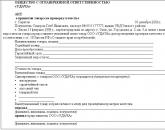What is the cost of production in simple words
It is rather difficult to give an unambiguous definition of the cost price, since this indicator has several types. In general, the cost price shows the amount of the company's costs for the performance of a particular activity or maintenance of the state. Cost indicators directly affect the final cost of products, and are also necessary when calculating the profitability of an enterprise. Another application of cost estimates can be the filing of a customs declaration, if customs officials suspect an undervalue of the goods, then providing a detailed cost estimate will help to avoid delay. Normally, product costing is the responsibility of the accountant.
There is the following cost classification:
- The workshop includes all the costs that are necessary for the production of products, including raw materials, staff wages, energy costs.
- The production cost takes into account the shop cost, the cost of auxiliary production and enterprise management.
- Full consists of production, to which are added the costs of selling and promoting goods. Most often, it is precisely this that is understood under the concept of the cost of goods.
- Indirect (general business) consists solely of the costs of managing the company, and does not take into account the costs of production.
Note: the choice of the required type of cost is solely in the competence of the company's management. Usually, if production or workshop costs are used, then in separate columns of the documentation, the costs of managing and selling the goods are also indicated.
Cost classification
This division is rather arbitrary, it is necessary to improve the analysis of the enterprise's activities and may differ depending on internal rules. Typically, direct costs include materials, labor wages, and equipment maintenance. It is quite difficult to reduce them, as a rule, such a step involves the transition to a new technological process, which means that it requires large investments. Indirect costs are more likely to be needed to increase product sales and effectively manage the production process, they can change significantly over time, for example, due to increased supplies and expansion of production.
Another type of classification is the division of costs into relevant and irrelevant. The first category depends on decision-making, while the second is impossible to manage, usually it includes natural disasters, accidents. However, the relevance of costs is determined only for a specific situation, for example, a fire can be the result of both a safety violation and a technical defect in the equipment.
Depending on the volume of production, costs can be fixed or variable. An example of the second type is the purchase of energy and consumables. The remuneration of workers rather belongs to the first type, since it does not always depend on the volume of production. Selling expenses are the most difficult to categorize, because with a decline in production, the size of the advertising budget usually increases, but at the same time, the income of managers decreases due to the deprivation of their bonuses. The company should try to minimize fixed costs to reduce the final cost of goods.
Read also: What is KPI as an indicator and criterion for evaluating performance
Calculation methods
Depending on the type of product produced, various methods of calculating the cost can be used:
- Transverse. Repartition is a separate stage in the production of a product, from this term the method got its name. It is most often used at the enterprises of the metallurgical, food and oil refining industries. Usually, in this method, material costs are taken into account in a separate category, and labor costs and energy consumption are calculated for each redistribution.
- Process. This method is used in enterprises with a continuous production cycle and a limited number of products, for example, in the energy, mining, and transport sectors. It allows you to evaluate the cost of not only sold products, but also semi-finished products that are formed during the production process, as well as inventory.
- Custom. This method includes an individual approach to the evaluation of products, for the calculation it is necessary that the product is already ready. Common in non-serial production, for example, construction or repair work, tailoring.
- Postoperative. This method of calculation is a kind of order method, it allows you to pre-evaluate the production of non-standard items made according to an individual project. In this case, the production has several standard stages through which each product passes, it is for them that calculations are applied, the cost of the rest is estimated after the fact.
The simplest formula for calculating the cost of production is: C = Z/X, where C is the cost, Z is the cost of the enterprise for the period under consideration, X is the number of goods or services produced. It works only in the case of the production of one type of product.

Many factors affect the cost
Data for calculation
The value of the cost may vary depending on the time period. This may be due to seasonal characteristics of the production, storage and transportation of goods or the price of raw materials. Sales volumes can also have an impact on the cost price, it is known that large lots of any goods are much cheaper. If the production capacity of the enterprise is not fully loaded, then the price of one unit of production rises. The reason for this is lower labor productivity with identical pay. Therefore, it is possible to talk about the cost price only for a certain period of time.
There are three main types of calculation:
- Normative. As a rule, it is carried out monthly, based on up-to-date data on the consumption rates of materials and other types of costs. Its purpose is to identify changes in the cost of production in order to assess the efficiency of the enterprise and adjust the price.
- Planned. The calculation is carried out in order to establish the average cost of goods for a certain period of time or for a specific order. The data are averages based on the performance of the enterprise for previous periods and their expected change. It may significantly differ from the norm up or down.
- Reporting. The calculations use the data of accounting documentation, the purpose of this type of calculation is to determine the actual cost of the goods. Conducted at the end of each reporting period.
Popular
- How to get a TIN: possible ways
- What kind of business can you do?
- Written notice of termination of the lease
- Business from scratch. Things to do?
- Cost of goods sold: formula, methodology and calculation example
- How to write a vacation application - examples
- What kind of business can be opened in a small town or village?
- The formula for calculating the cost of services, products sold and total cost
- Sample memorandum: I bring to your attention
- Example of an explanatory note for being late for work




